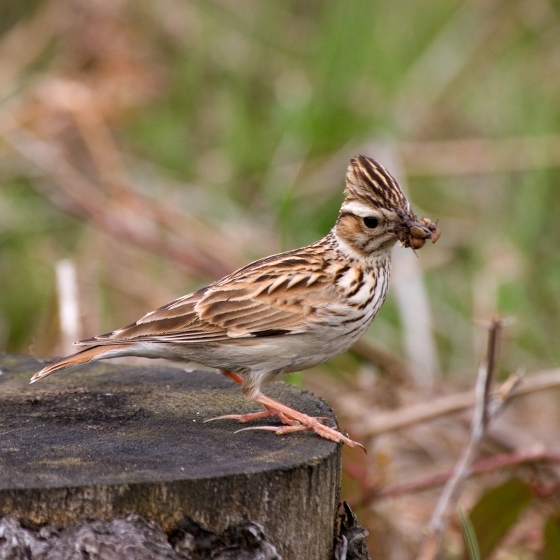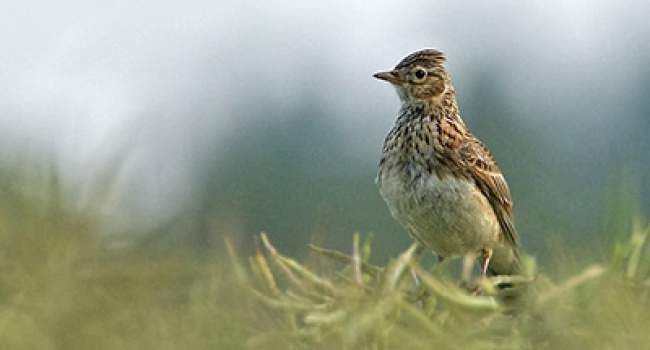Woodlark
Lullula arborea (Linnaeus, 1758)
WL
 WOODL
WOODL  9740
9740

Family: Passeriformes > Alaudidae

Very much a bird of wooded heath, the lilting song of the Woodlark can be heard on sunny days throughout the year.
Woodlarks are patchily distributed in the UK, from the heaths of East Yorkshire to East Anglia, the New Forest and Dartmoor. It is not found in on the island of Ireland. During the winter months Woodlarks gather in small flocks, often close to their breeding areas. Sometimes as many as 50-60 birds can be seen feeding together, seeking out seeds and invertebrates.
The Woodlark is one of the few birds in the UK with a supercilium, the stripe above the eye, that meets on the back of the head. It also has a distinctly short tail.
Exploring the trends for Woodlark
Our Trends Explorer will also give you the latest insight into how the UK's Woodlark population is changing.
trends explorerIdentification
Woodlark identification is sometimes difficult. The following article may help when identifying Woodlark.
Identifying Skylark & Woodlark

Lauded by poets for their wonderful, uplifting song, larks are rather nondescript birds when seen. There are two species regularly found in Britain and Ireland and their ranges and habitats do overlap, so how can we tell them apart?
SONGS AND CALLS
Listen to example recordings of the main vocalisations of Woodlark, provided by xeno-canto contributors.
Call
Song
Develop your bird ID skills with our training courses
Our interactive online courses are a great way to develop your bird identification skills, whether you're new to the hobby or a competent birder looking to hone your abilities.
Browse training coursesStatus and Trends
Population size and trends and patterns of distribution based on BTO surveys and atlases with data collected by BTO volunteers.
CONSERVATION STATUS
This species can be found on the following statutory and conservation listings and schedules.
POPULATION CHANGE
This species is too rare and restricted in range for population changes to be monitored annually by BTO volunteer surveys. A 62% reduction occurred in the number of 10-km squares occupied between 1968-72 and 1988-91; the species had ceased to breed in Wales and in several southern English counties over this period (Gibbons et al. 1993). Sitters et al. (1996) report that the UK population increased from c.250 pairs in 1986 to c.600 pairs in 1993. A repeat national survey in 1997 showed that the population had increased further, accompanied by expansion of the range into new areas (Wotton & Gillings 2000). A further repeat in 2006 recorded just over 3,000 pairs: an increase since 1997 of 88% accompanied by major range expansion, with a pair breeding in Wales for the first time since 1981 (Conway et al. 2009). However, numbers dropped following the severe winters in 2008/09 and 2009/10 (Holling & RBBP 2012; APEP4). As a result of these population changes, Woodlark was dropped as an RBBP species in 2012 but reinstated in 2016.
Atlas data for 2008-11 indicate losses of range since 1968-72 in southwestern and southern England, and in Wales, offset by expansion in central southern England and northwards in eastern England (Balmer et al. 2013). The species' partial recovery in numbers and range resulted in a move from the red to the amber list at the 2009 review (Eaton et al. 2009) and on to the UK green list in 2015 (Eaton et al. 2015).
There has been an increase across Europe since 1980, although this trend should be treated with caution as the data from early years are based on limited geographical coverage (PECBMS: PECBMS 2020a>).
Exploring the trends for Woodlark
Our Trends Explorer will also give you the latest insight into how the UK's Woodlark population is changing.
trends explorerDISTRIBUTION
The core part of the Woodlark's breeding range is Devon, the New Forest, and the heaths of the Thames Basin and East Anglia. Additionally there are new populations in the West Midlands, northern England and South Wales. In the 1980s Woodlarks usually departed their East Anglian breeding areas in winter, but now many remain year round. With these and others wintering near central and northern England breeding areas, the winter range is four times larger than it was in the 1980s.
Occupied 10-km squares in UK
| No. occupied in breeding season | 155 |
| % occupied in breeding season | 5.1 |
| No. occupied in winter | 243 |
| % occupied in winter | 8 |
European Distribution Map
DISTRIBUTION CHANGE
Woodlark distribution has changed considerably since the 1970s. Between 1968–72 and 1988–91 the range contracted by 63%, largely through losses on farmland in Wales and southwest England. Subsequently, a 107% range expansion took place up to 2008–11
Change in occupied 10-km squares in the UK
| % change in range in breeding season (1968–72 to 2008–11) | -23% |
| % change in range in winter (1981–84 to 2007–11) | +296.4% |
SEASONALITY
Some Woodlarks are present throughout the year but arrivals and song activity means most likely recorded from late winter onwards; a noticeable peak in late autumn of passage birds, most detected in flight.

Movement
Information about movement and migration based on online bird portals (e.g. BirdTrack), Ringing schemes and tracking studies.
An overview of year-round movements for the whole of Europe can be seen on the EuroBirdPortal viewer.
RINGING RECOVERIES
View a summary of recoveries in the Online Ringing Report.
Foreign locations of birds ringed or recovered in Britain & Ireland

Biology
Lifecycle and body size information about Woodlark, including statistics on nesting, eggs and lifespan based on BTO ringing and nest recording data.
PRODUCTIVITY & NESTING
Exploring the trends for Woodlark
Our Trends Explorer will also give you the latest insight into how the UK's Woodlark population is changing.
trends explorerSURVIVAL & LONGEVITY
View number ringed each year in the Online Ringing Report
Maximum Age from Ringing 
|
7 years 2 months 1 days (set in 2017) 
|
Typical Lifespan 
|
3 years with breeding typically at 1 year |
Adult Survival 
|
0.6±0.03  
|
Juvenile Survival 
|
0.22 (in first year) 
|
Exploring the trends for Woodlark
Our Trends Explorer will also give you the latest insight into how the UK's Woodlark population is changing.
trends explorerCODES & CLASSIFICATION
Ring size 
|
A (pulli B) |
Field Codes 
|
2-letter: WL | 5-letter code: WOODL | Euring: 9740 |
For information in another language (where available) click on a linked name
Research
Interpretation and scientific publications about Woodlark from BTO scientists.
CAUSES AND SOLUTIONS
Causes of change
The causes of change are uncertain, but increased habitat available and climate change may both have benefited Woodlark.
Further information on causes of change
The increase from c.250 pairs in 1986 to c.600 pairs in 1993 was probably helped by mild winters and increased habitat availability due to storm damage in plantations, forest restocking, and heathland management ((Sitters et al. 1996)).
Farmland setaside, especially close to forest, was valuable additional habitat for the expanding population, although clutch sizes may be lower there than in more traditional habitats (Wright et al. 2007). Climate change may benefit Woodlark, because it is able to make more nesting attempts in warmer years (Wright et al. 2009). The cold 2008/09 and 2009/10 winters may, however, have brought about the reduction in numbers reported to RBBP for 2010 (Holling & RBBP 2012; Woodward at al. 2020: APEP4). The small NRS sample suggests that nest failure rates have become less frequent at the egg stage. There has been no trend, however, in the number of fledglings per breeding attempt. Human disturbance at heathland sites apparently reduces population density, but the effects are partly offset by higher breeding productivity at lower densities (Mallord et al. 2007).
Information about conservation actions
The Woodlark has increased in numbers since the 1980s, although it is restricted by its habitat requirements and so remains vulnerable, and is an RBBP species.
Disturbance caused by human recreational activity at heathland sites may reduce population density. In one study, the probability of suitable habitat patches being occupied was reduced to below 50% at around eight disturbance events per hour (Mallord et al. 2007). Modelling carried out as part of this study suggested that, where possible, increased visitor numbers should be concentrated on sites which are already disturbed as this would have much less effect on the woodlark population than increased visitor numbers across all sites.
Provision of suitable heathland and woodland habitat could also benefit the Woodlark. The species requires patches with substantial proportions of bare ground and short vegetation (Mallord et al. 2007). Annual ground disturbance within c.45 m of woodland successfully increased Woodlark numbers on a lowland grass-heath with closed swards (Hawkes et al. 2019). Woodlarks in Polish commercial forests prefer areas with new regrowth (less than five years old) but with some mature trees retained and with a higher proportion of forest edge habitats (Mallord et al. 2007). In the Mediterranean, the population has increased following land abandonment which has created a heterogeneous landscape of farmland and shrubland (Sirami et al. 2010), given the differing climates it is unclear whether creating set-aside in the UK close to existing populations might have a similar effect; farmland set-aside fields are used in Breckland, but may be sub-optimal to other breeding habitats (Wright 2006).
Links to more studies from ConservationEvidence.com
Would you like to search for another species?










Share this page